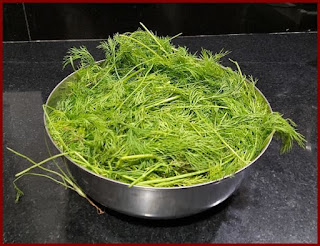 |
| NUCHHINUNDE |
Nuchhuna unde is
prepared from Tuvar dhal (Pigeon peas). Some people use a mixture of Tuvar dhal
and Bengal gram dhal. Nuchhu is
broken pieces of grains. In olden days de hulling was done by stone chakki consisting of 2 grinding stones, where
the lower one was immovable and the upper one rotating, which was operated
manually. During the process of dehulling of Tuvar dhal beans, plenty of seeds
used to get broken in to small pieces which are called Thogari nuchhu. These
broken pieces of tovar dhal are used in the preparation Thogari nuchhina unde. Due to modern technology there will not be
much nuchhu formed during dehulling in dhal mills. As Thogari nuchhu is not available
we brake whole dhal and prepare nuchhinunde! Nuchhinunde is prepared with
onion, carrot gratings, Pudina leaves, Sabsige soppu (Dill leaves). Fenugreek
leaves can also be added.
Along with nuchhinunde, Hasi
maggige huli is prepared as dip which is prepared from thick curds.
INGREDTENTS
For Nuchhinunde
Tuvar dhal: 1 cup
Green chillies: 6
Onion: 1 finely chopped
Carrot: 1, grated
Curry leaves: 2 sprigs, broken into small pieces
Chopped coriander leaves: 2 table spoons
Asafoetida
Turmeric powder: ½ teaspoon
Salt: to taste
Coconut gratings: 2 table spoons
Coconut pieces: 2 table spoons
For Hasi majjige huli
Ingredients
Thick curds: 2 cups
Green chillies: 3
Coconut gratings: 4 table spoons
Mustard: ½ teaspoon
Asafoetida
Salt
For seasoning
Cumin seed: ½ tea spoon
Mustard seeds: ½ tea spoon
Red chilli: 1 broken in to pieces
Asafoetida: one pinch
Turmeric powder: ½ teaspoon
Curry leaves: 2 sprigs
Chopped coriander leaves: 1 table spoon
Salt: ½ teaspoon
Oil or ghee 2 tea spoons
Method
Nuchhinunde
Wash and soak Tuvar dhal for 2 hours. Drain the water well. Pulse
the dhal in to a coarse paste along with green chillies, salt, turmeric powder
and asafoetida without adding water. I prefer to grind in a chutney jar to the
big jar for this purpose as I get uniform coarse paste.
Transfer the paste in to a bowel. Add chopped onion, curry
leaves, coriander leaves, coconut gratings, coconut pieces and mix well. Add
more salt if needed. Allow to stand for a few minutes.
Paste should not be too thick or thin. Add some water to the
paste if needed. If the paste is too tight Nuchhinunde will become very hard
after it is cooked, if it is thin you cannot shape bolls.
 |
| STEAMED NUCHHINUNDE |
Make oval shaped balls and place them in a greased idli
mould and steam for 20 minutes in a pressure cooker covering the vent with a
tumbler. Cool it and transfer to a dish. Serve worm nuchhinunde with ghee and
Hasi majjige huli
HASI MAJJIGE HULI
 |
| HASI MAJJIGE HULI |
Method
Grind coconut gratings, mustard, salt, turmeric powder, asafoetida
with 2 spoons of curds to a smooth paste. Beat the remaining curds well. Add
ground paste and mix well. Add salt if needed.
Heat 2 teaspoons of refined oil or ghee in a pan. Add mustard,
cinnamon, turmeric powder, broken red chilli pieces. When they are done add
curry leaves, mix well and cool. Add the seasoning to the curd mixture and mix well.
Hasi majjige huli is ready.
Serve hot Nuchhinunde with ghee and Hasi majjige huli.






















































